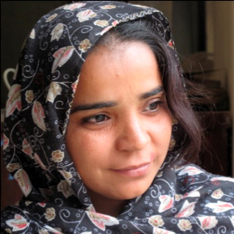Farzana Habib was married at twelve to a man three times her age.
“I knew he was very old, but I had no choice. But I was happy because he let me run (informal) classes for young girls, mostly about Quran, but we used the classes to discuss issues of girls, in an Islamic (context).â€
When she heard about the possibility of a school in her village, Farzana’s heartbeat quickened.
“I talked to all the mothers, I invited them to Quran classes to discuss the DIL school, I encouraged them to send the girls, told them it was an opportunity.â€
When Farzana persisted, the mothers told her that if she could somehow get permission to attend DIL’s school, then they would entrust their daughters to her care. Farzana realized that she was being asked to chaperone the girls. She played the role of an intermediary, monitoring the new ideas their daughters were being exposed to.
“I knew my husband would never allow me to go to school, so I convinced my mother to lie for me. I hid one uniform at her place, and one uniform at my cousin’s place and started to learn lessons with the girls. Women laughed because I was much older than the other girls, but I didn’t care, I was learning and it felt like a dream for to get new knowledge.â€
Some days her husband, who began to fall sick, would stay home to rest. On those days she would send a child with a message to the teachers apologizing and asking for the days’ lessons. The teachers would stay late, and go over the lessons again after school was closed so that she could keep up to speed. Farzana and the girls began to read, earning the respect of the community with their speedy progress.
Her husband eventually died, “either of gas fumes he inhaled at work, or of old age, I don’t know. But then I had to have an income or beg from my family, who live in poverty, that’s why I had to marry, so I decided to work.â€
The idea for a clothing retail business had been percolating in her head since  she first overheard women in the village complaining about their husbands’ habit of buying yards of the same fabric for every female in the family. Because the women were not allowed to go to the market, the men of their families picked the colors and patterns the women would wear.
she first overheard women in the village complaining about their husbands’ habit of buying yards of the same fabric for every female in the family. Because the women were not allowed to go to the market, the men of their families picked the colors and patterns the women would wear.
She began by selling her cow for 6000 Rupees for seed capital, and then training her father and brother to pick fabrics that would please her female clientele. At first perplexed, and finally frustrated by this complicated process, they eventually allowed Farzana to go with them to the market in full purdah so that she could do the choosing herself.
The women would wait for news of her return and gather to browse and shop in the sanctity of Farzana’s “Chaar-diwari†(literally four walls of her home) where they could take off the “chaador†and relax. She made turned a profit of 50 rupees per fabric piece sold.
“DIL teachers put a lot of confidence inside me, I watched these women, they work outside their home and they do nothing wrong, now I think women can work without losing their honour, outside the home, and bring income without bringing shame to the men of the family. At first my family said what will people say, you have a father and brother and we cannot provide for you. But I told the family the whole village respects the DIL teachers, so I gave their example and I got permission to start my business.
The teachers attribute part of their ability to grow their student body from 30 to 130 to Farzana Habib’s incessant lobbying on their behalf.

